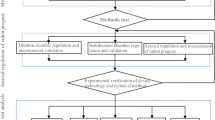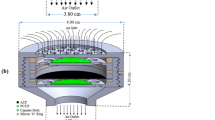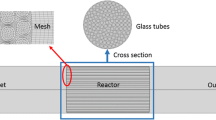Abstract
In this study, a tubular radon removal device and a movable one were prepared and investigated. The tubular radon removal device in an air conditioning return air system reduced the radon progeny by more than 84%. The radon progeny concentration reached equilibrium after 4 h when it was used only for a ventilation at the rate of 10 h−1. Radon progeny removal efficiency was above 95% for the movable radon removal device, when the ventilation rate was 17 h−1. The results showed that the radon removal devices can effectively remove the radon progeny in the air.









Similar content being viewed by others
References
UK Health Protection Agency (2009) Radon and Public Health (RCE-11): Report Prepared by the Subgroup on Radon Epidemiology of the Independent Advisory Group on Ionizing Radiation. Documents of the Health Protection Agency: Radiation, Chemical and Environmental Hazards
Watson SJ, Jones AL, Oatway WB, Hughes JS (2005) ionising radiation exposure of the UK population: 2005 review. J Radiol Prot 25(4):493–496
Rees DM, Bradley EJ, Green BMR(2011) Radon in Homes in England and Wales: 2010 Data Review. HPA-CRCE-015. HPA, Chilton, UK
United States Environmental Protection Agency (2013) EPA does not provide oversight of radon testing accuracy and reliability. BiblioGov vol 2013, pp 1–22
Ruano-ravina A, Dacosta-urbieta A, Barros-dios JM, Kelsey KT (2018) Radon exposure and tumors of the central nervous system. Gac Sanit 32(6):567–575
Tirmarche M, Harrison JD, Laurier D, Paquet F, Blanchardon E, Marsh JW (2010) Lung cancer risk from radon and progeny and statement on radon. Ann Icrp 40(1):1–64
Valentin JE (2007) ICRP Publication 103: the 2007 recommendations of the international commission on radiological protection. Ann ICRP 37(2–4):1–332
International Agency for Research on Cancer (1988) Monographs on the evaluation of carcinogenic risks to humans: man-made mineral fibers and radon, lyon, France. IARC 1988:198–240
Misdaq MA, Elharti A (1997) Study of the influence of the lithological and hydrogeological parameters of aquifers on the radon emanation from underground waters using solid state nuclear track detectors. J Radioanal Nucl Chem 218(2):209–214
Sung HH, Jae BP, Wha MP (2017) Radon and NO2 levels and related environmental factors in 100 underground subway platforms over two-year period. J Environ Radioact 181:102–108
Elío J, Crowley Q, Scanlon R, Hodgson J, Zgaga L (2018) Estimation of residential radon exposure and definition of radon priority areas based on expected lung cancer incidence. Environ Int 114:69–76
Qi W, Geng SB, Gao HB, Zhou WS, Jiang F (2011) The research status and application of radon reduction technology in defense projects. Contam Control Air-cond Technol 1:38–42
United States Environmental Protection Agency (1993) EPA map of radon zones. USEPA Publication 402-R-93-071: Washington, DC
United States Geological Survey (2001). Pennsylvania radon study map. https://www.usgs.gov/media/images/pennsylvania-radon-study-map. Accessed 2 Nov 2018
British Geological Survey (2011) User Guide for the HPA-BGS Joint Radon Potential Dataset for Great Britain. British Geological Survey: Open Report IR/11/044
British Geological Survey (2013) User Guide for the PHE-GSNIBGS Joint Radon Potential Dataset for Northern Ireland. British Geological Survey: Open Report OR/13/048
Dieguez-Elizondo PM, Gil-Lopez T, O’Donohoe PG, Castejon-Navas J, Galvez-Huerta MA (2017) An analysis of the radioactive contamination due to radon in a granite processing plant and its decontamination by ventilation. J Environ Radioact 167:26–35
Europe Commission (1995) Indoor air quality and its impact on man: radon in indoor air. Europe Commission, Report No. 15
United States Environmental Protection Agency (2009) Residential air cleaners: a summary of available information. USEPA Publication 400-F-09-002, Washington DC
United States Environmental Protection Agency (2000) Radiation Protection at EPA. USEPA Publication 402-B-00-001, Washington, DC
Iwaoka K, Tokonami S, Yonehara H (2013) Mitigation effects of radon decay products by air cleaner. J Radioanal Nul Chem 295(1):639–642
Bigu J (1993) Radon progeny reduction by means of an air cleaner of the polarized media type. Ann Occup Hyg 37(5):481–496
Lazo E, Smith R, Coates R, Andersen R, Asano Y, Chapple C-L, Faulkner K, Hefner A, Hill M, Jones R, Larsson C-M, Liebenberg G, Liland A, McKinlay A, Menzel H-G, Perks C, Rodriguez M, Schieber C, Shaw P, Visage A, Wakeford R, Ye S-J (2012) The state of radiological protection; views of the radiation protection profession: iRPA13, Glasgow, May 2012. J Radiol Prot 32(4):489–524
Streil T (2000) Exploration of radon affected work and living places and methods for the reduction of the radon exposure. In: Proceedings IRPA 10-10th international congress of the international radiation protection association. Hiroshima, P-1b-S1
Guo HP (2013) Introduction to radon. Northwestern polytechnical University Press, Xian
Author information
Authors and Affiliations
Corresponding authors
Rights and permissions
About this article
Cite this article
Yuan, L., Geng, S., Mao, J. et al. Investigating the mitigation effects of radon progeny by composite radon removal device. J Radioanal Nucl Chem 319, 205–211 (2019). https://doi.org/10.1007/s10967-018-6340-0
Received:
Published:
Issue Date:
DOI: https://doi.org/10.1007/s10967-018-6340-0




